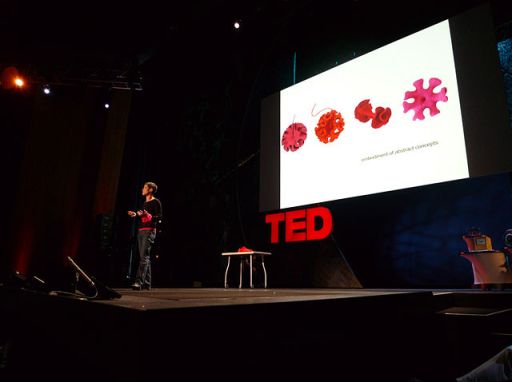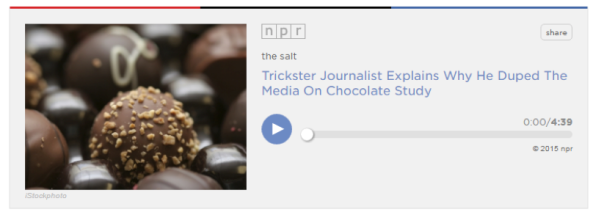I am a TED enthusiast.
TED is an organization that describes itself as a “nonpartisan nonprofit devoted to spreading ideas, usually in the form of short, powerful talks.” Chances are you’ve seen a TED talk at some point – maybe Meg Jay‘s advice for 20-somethings or Bryan Stevenson’s talk about the issues in our criminal justice system? They are fascinating and inspiring, and offer glimpses into a huge variety of topics that I don’t get to think about on a daily basis. I even teach a class for first-year undergraduate students that is focused on discovering their passions and how to give a TED-style talk about those passions.
But as much as I love TED, lately I’ve been thinking about the challenges that come with having such a huge and devoted audience, and how that relates to the responsibilities of science communication in general. How do we as scientists balance our desire to engage and get the public excited about science, and the need to convey the complexity and nuances of research?

This summer while I was attending a TED conference, I started thinking a lot about the relationship between practicing scientists, media, and the public. Specifically, I’ve been thinking about who has the responsibility, and even the privilege, to insure that the public engages deeply and benefits maximally from scientific research. Within the tribe of TED attendees, there was a vibrant discussion about how TED could avoid promoting pseudoscience, where pseudoscience “is a claim, belief, or practice presented as scientific, but which does not adhere to the scientific method.”1 TED needs to worry about this because they are an assumed authority, and their endorsement of a presented topic lends credence to the topic presented. There are a couple famous examples of really popular TED talks that present questionable science.
John Oliver recently did an excellent critique of sloppy science communication, including a TED parody called TODD (Trends, Observations, and Dangerous Drivel). The TODD section starts at about 15:50 in the video below (warning in case you’re watching with kids: there’s a little strong language just before that).
The same tension between entertainment and careful nuance in science communication is true for other organizations and societies, not just TED. Groups like the National Science Foundation (the funder of our Center for Sustainable Nanotechnology), the American Chemical Society, and the National Academy of Sciences all have missions to share science with the public as well as to support research. While these organizations are scientific at their core and their risk tolerance is lower than TED’s, they also have less media presence than TED, so whatever content they produce just doesn’t get seen by as many people.
This means that mainstream media is the most likely route that the public has to receive scientific content. But how does that content get chosen? Both TED and mainstream journalists want to choose speakers and messages that are engaging and attention-getting. While not necessarily mutually exclusive with being scientifically significant, these engaging and attention-getting scientists and science stories are not always the best or most important science. In fact, professionals in the “hard sciences” are stereotypically known as not being particularly effective communicators. Some practicing scientists think that a “flashy” presenter is more salesperson than scientist, and can be suspicious that a sound-bite or attention-getting story will be misleading. (A scientist and journalist recently teamed up to demonstrate this by doing a bogus “study” about how chocolate can help you lose weight – even though it was a terrible study, it made headlines around the world.) To make things worse, most scientists get very little formal communication training, so even those who are motivated to reach out and present their research to the public may have a hard time with it.

With all this in mind, I’m sure you can see the crossroads we’re at: the public sometimes finds science intimidating and unapproachable, scientists are not always the most effective communicators, and the media is choosing which scientists and scientific stories will bridge this gap often based on style rather than substance. In effect, journalists and TED curators are the de facto peer review for the science that reaches the masses. This is an enormous responsibility that has to be done within the pressing 24/7 news cycle. To get accurate information out to the public, this means that practicing scientists must take an active role. I have no easy answers about how this can be done better, but I’d like to pose some questions that can start conversations on this important topic:
- The public wants a clear, understandable “answer” from scientists on their topics of expertise but that’s not how science works. How do we keep science/results palatable but also keep the very real/important nuance?
- How do we make sure that the most impactful science thrives rather than the science coming from only the most compelling or loudest advocates?
- How can we train scientists to balance accessibility and nuance in communication? Based on common natural abilities, I think this means incorporating meaningful coaching on this topic into our higher education science curricula that doesn’t just aim to reduce the science to the broadest, simplest conclusion.
- Must it be OK for different organizations/publications to have different “risk profiles” for when to share new scientific ideas/results (e.g. Science, Nature, Cell, TED)? How do these “higher risk” entities balance desire for “hot” headlines with scientific longevity? How do they convey their risk tolerance to their audience?
- How can scientists show more data, citations, and precedent work in media presentations without compromising artful slides/stories and losing the attention of the public audience?
I think one way to start making progress on this important issue is by having conversations stimulated by questions like these among researchers, within society/organization leadership, between journalists and scientists, between mentors and junior scientists, and of course with members of the public audience. I believe it is our responsibility as scientists, and especially as tax-dollar-funded scientists, to make sure the general public benefits from the science we do. To that end, we all need to either gain more skills for – and commit more time to – communication with the public, or we need to actively pursue collaboration with skilled science journalists. Let’s all work together to make sure the very best science being done is visible and consumable by the general public. The positive feedback loop created by this kind of engagement will almost certainly facilitate even more exciting research opportunities.
I hope the questions I’ve suggested here can be the starting point for some of these conversations. Please let us know if you use them in a class, workshop, or discussion group!
EDUCATIONAL RESOURCES
- Leonore Annenberg Institute for Civics: Everything you know is wrong 2: Beliefs & Behaviors (pseudoscience classroom activity)
- CPALMS: Science vs. Pseudoscience lesson plan (grade 8)
REFERENCES
- Pseudoscience. [n.d.] in Wikipedia, retrieved Oct 3, 2016 from Wikipedia pseudoscience

This question: “How can scientists show more data, citations, and precedent work in media presentations without compromising artful slides/stories and losing the attention of the public audience?” reveals a misunderstanding of communication with humans. Data, citations, and precedents do not matter when communicating with the public. They only matter to other scientists. That’s not cynicism; it has been shown repeatedly by data- citation- and precedent-laden peer reviewed studies. Facts do not speak for themselves and what people understand and believe is shaped more by their social groups than evidence.(Which is why scientists do want data.) You don’t have to look much farther than the current US presidential election for a conspicuous example. This does not mean that data don’t matter; they do, and they can and often should be presented. But what’s convincing to audiences is how the facts are communicated, not what they are. Scientists recoil from this idea, but the evidence for this that they would like is all there, but in a literature they don’t read. Communication, like science, is an interdisciplinary, collaborative domain, and scientists need to appreciate that so people will listen to them.
I interpreted this question as being as much about how we communicate the process of science as it is about communicating the fact/result/story at hand, and I think process requires information about data and precedent… Maybe you’d disagree with my assumption that science communication should include information about the process? An interesting debate! And even if we agreed that we were trying to communicate about process, it’s still up for discussion what the best ways are to do that…
I don’t interpret the question as being about process, but I think the same facts would apply. Anything you want the public to remember has to be made memorable on their own terms. Data are unlikely to be useful, but for both data and precedent your result – which I assume to be paying attention, understanding, remembering, and perhaps taking action – depends more on how they are presented. There are decades of evidence for this, as well as every advertising success you’ve ever seen. There’s even a Nobel prize tucked into the precedents.
Agreed, this is a great post. My personal belief is that somewhere down the line people have to start getting comfortable with answers that aren’t so clear cut – I don’t know whether that’s actually possible, but I guess scientists can do it… On question 5, making data accessible is an important and rare skill set, but Ed Hawkins has recently been doing an amazing job on climate data, see: http://www.climate-lab-book.ac.uk/spirals/
Great questions! Great post! I’m giving a talk next week on science communication here at UC Berkeley to a group of grad students, and I will definitely let you know if I end up using any of these questions as discussion starters.
Very cool! We look forward to hearing how it goes 🙂